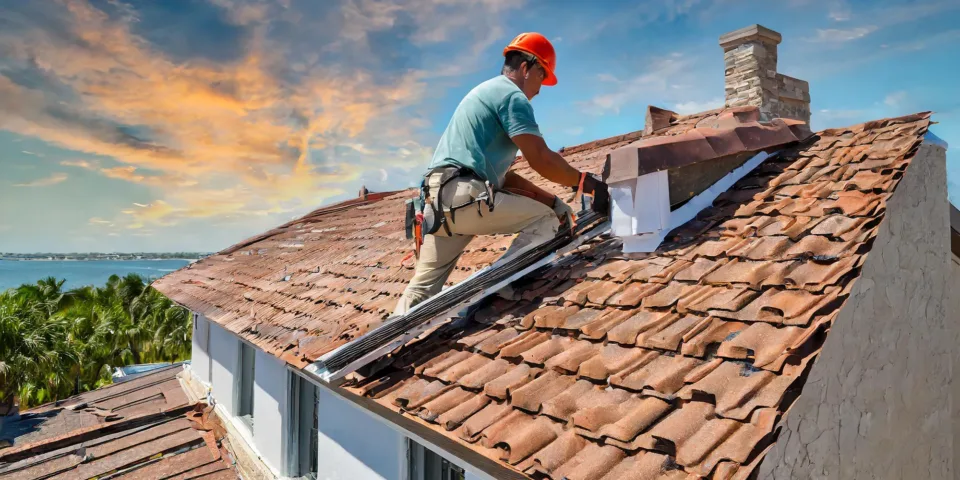In This Article
As the world continues to shift towards sustainable energy solutions, solar roofing has emerged as an innovative and efficient way to power homes while maintaining a sleek and modern aesthetic. This in-depth guide explores how solar roofing works, the technology behind it, and why more homeowners are making the switch.
What Is Solar Roofing?
Solar roofing refers to a roofing system that integrates solar energy-generating technology directly into the roof’s structure. Unlike traditional solar panels, which are mounted on top of an existing roof, solar roofs use shingles or tiles that double as both roofing material and solar energy collectors. These systems are designed to blend seamlessly into your home’s architecture while generating electricity from the sun.
There are two main types of solar roofing:
- Traditional Solar Panels: Mounted on top of the roof, these panels are typically more visible but are often more efficient and cost-effective. They can be installed on most existing roof types.
- Integrated Solar Shingles: Built into the roof for a more aesthetically pleasing appearance, these provide a seamless look and often mimic traditional roofing materials like asphalt or slate.
How Solar Roofing Works
The Science Behind It
Solar roofing systems work by converting sunlight into electricity using photovoltaic (PV) cells. These cells are embedded in solar shingles or tiles and absorb sunlight throughout the day. When sunlight hits the PV cells, it generates direct current (DC) electricity. This DC power is then sent to an inverter, which converts it into alternating current (AC) electricity, the standard used in homes.
CLASSIC ROOFING – FAMILY OWNED AND SERVING THE COMMUNITY FOR OVER 20 YEARS
CLASSIC ROOFING – FAMILY OWNED AND SERVING THE COMMUNITY FOR OVER 20 YEARS
The efficiency of this process can depend on various factors including roof orientation, geographic location, shading from trees or other buildings, and the quality of the solar technology used.
Components of a Solar Roofing System
- Solar Shingles or Tiles: These are the heart of the system, capturing solar energy and initiating the energy conversion process.
- Inverter: Converts the DC power generated by the solar cells into usable AC power for your home appliances.
- Electrical Panel: Distributes the converted electricity to power your lights, devices, and appliances.
- Battery Storage (Optional): Stores excess energy generated during the day for use at night or during power outages.
- Net Metering System: Allows you to send unused power back to the grid, often earning you credits or reducing your utility bill.
Types of Solar Roofing Materials
Choosing the right material is crucial for maximizing efficiency and aesthetic appeal.
Solar Shingles
These are designed to integrate with traditional asphalt shingles. They are smaller and more discrete than traditional panels and can cover the entire roof or just a portion of it.
Solar Tiles
Often made from tempered glass, solar tiles resemble high-end materials such as slate or ceramic. They are popular in luxury homes and historic buildings where maintaining visual appeal is essential.
Building-Integrated Photovoltaics (BIPV)
This category includes not just roofing materials but also solar windows and facades. BIPV systems allow entire structures to contribute to solar energy generation, making buildings highly energy efficient.
Key Benefits of Solar Roofing
- Lower Energy Bills: By generating your own electricity, you can significantly cut or even eliminate your monthly energy costs.
- Eco-Friendly: Solar energy is a renewable, clean energy source that reduces greenhouse gas emissions and dependence on fossil fuels.
- Incentives: Federal, state, and local programs often offer tax credits, rebates, and grants to help offset installation costs.
- Home Value: Studies show that homes with solar systems sell faster and at higher prices than those without.
- Sleek Design: Integrated systems offer a clean, modern look that enhances your home’s curb appeal.
- Energy Independence: Reduce your reliance on the power grid, which can be especially beneficial in areas prone to blackouts or natural disasters.
How Solar Roofing Is Installed
Installing a solar roof is a multi-step process that involves careful planning and professional execution:
- Assessment: A site visit to evaluate your roof’s angle, shading, and structural integrity.
- Design & Permitting: Engineers design a system tailored to your energy needs, and necessary permits are secured.
- Installation: Solar shingles or tiles are installed either as a complete new roof or integrated into existing roofing.
- Inspection & Activation: After installation, the system is inspected by local authorities and utility companies to ensure it meets safety standards.
- Connection to the Grid: Once approved, your solar system goes live, and you begin generating power.
Solar Roof Maintenance and Lifespan
- Maintenance: Minimal. Most systems are self-cleaning with rainwater, but occasional manual cleaning may improve efficiency. Annual inspections are recommended to check for damage or degradation.
- Lifespan: 25–30 years for PV cells, with many systems maintaining high efficiency throughout that time. Roofing materials themselves are often warrantied for the same duration.
Solar Roofing vs. Solar Panels: What’s the Difference?
| Feature | Solar Roofing | Solar Panels |
|---|---|---|
| Aesthetics | Sleek and integrated | Bulkier appearance |
| Installation | Complex and time-consuming | Easier to install |
| Cost | Higher upfront | Lower upfront |
| Energy Efficiency | Slightly lower per unit | Typically higher per unit |
| Best For | New homes or full roof replacements | Existing homes |
Is Solar Roofing Right for You?
Consider these factors:
- Sunlight Exposure: South-facing roofs with minimal shading are ideal for solar energy production.
- Roof Condition: If your roof is older or needs replacement soon, it may be a good time to consider solar roofing.
- Budget: While solar roofing has a higher initial cost, long-term energy savings and incentives make it a cost-effective solution.
- Incentives: Federal tax credits, local rebates, and net metering programs can significantly reduce the net cost of your system.
- Aesthetic Preferences: If curb appeal and seamless design are important to you, solar shingles or tiles may be preferable to panels.
Common Questions About Solar Roofing
Do solar roofs work on cloudy days?
Yes, although output is reduced, PV cells still generate power in indirect sunlight. Overcast days will lower efficiency but will not completely halt energy production.
Can you walk on solar shingles?
Most are designed to be durable enough for light foot traffic, such as during maintenance, but it’s best to avoid walking on them unnecessarily.
What happens during a power outage?
Without battery storage, most systems shut down during outages to protect utility workers. With a battery backup, you can maintain power in your home.
Can you use batteries with solar roofs?
Yes. Batteries like the Tesla Powerwall or LG Chem RESU allow you to store excess power for use during outages or at night. This also provides greater energy independence.
How long does installation take?
The process from assessment to activation can take several weeks, depending on permitting, product availability, and weather. Installation itself usually takes 2-5 days.
Are solar roofs worth it?
For many homeowners, especially those planning to stay in their home long-term, solar roofing is a worthwhile investment. It provides clean energy, reduces utility bills, and adds value to the property.
Final Thoughts
Solar roofing is a forward-thinking investment that combines functionality, sustainability, and design. As solar technology continues to improve, solar roofs are becoming a more viable and attractive solution for homeowners around the world. By understanding how it works, the components involved, and the potential benefits, you can make an informed decision about whether it’s the right fit for your home.
Thinking about going solar? Contact us for a free estimate and personalized solar roof consultation today!
Award Winning Professionals Are Here To Help!





